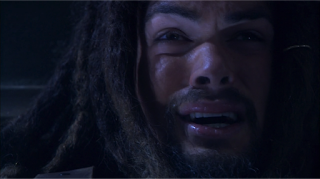In
an episode that opens with Rodney McKay getting shot in the ass, Ronon Dex gets
to revisit a chapter of his past for which he has no nostalgia. When the Atlantis team comes across a village
that Ronon had unwillingly sold out to the Wraith during his time as a runner,
the villagers capture the team and hand Ronon over to the Wraith in exchange
for his teammates’ freedom. He is sent
back to his homeworld of Sateda, let alone the planet’s capital city—now
ravaged by the Wraith.
Let’s
be real: the main theme of “Sateda” is revenge.
This episode is mainly about Ronon, who wants revenge against the Wraith
for ravaging his home planet and committing genocide against his people. On a side note, the villagers at the
beginning of this episode want revenge against Ronon for, from their point of
view, selling them out; as a runner, Ronon was briefly hospitalized in the
village, but left not long before his tracker led the Wraith straight there to
ravage it. Revenge is a common emotion
used to motivate a character, and it’s brilliantly executed here.
Firstly,
the villagers who want to turn Ronon in to the Wraith have a completely understandable
motivation: they are desperate for survival, and the Wraith had told them they
would stop attacking if they surrendered Ronon over. When a stranger waltzes into their village
and brings tons of alien invaders with him, it is just natural that they would
blame him, regardless of the fact it
was an accident from his point of view.
The fact that they refuse to listen to Teyla’s warnings that the Wraith
will not stick to their end of the bargain highlights their desperation.
However,
the bulk of this episode focuses on Ronon becoming a runner again on his home
planet, in a Wraith sport that could be best described as the most terrifying
game of tag ever conceived. As he is
chased through his former home, the story is allowed to delve further into how
the Wraith has affected him psychologically.
For example, almost all of Ronon’s backstory is told through flashbacks
as he navigates the ruins of his own home.
It is not uncommon for him to stumble upon old remnants of his past,
still left mostly undisturbed after the Wraith invasion, and have traumatic
flashbacks of the invasion triggered in his mind and shown onscreen.
Ronon
Dex was Jason Momoa’s breakthrough role, and it is clear he had fully sunken
into it by this episode—he delivers a rather strong performance here. Multiple times, Ronon reacts to his own
flashbacks with his subtle facial expressions to show how much of a toll this
has had on him. The flashbacks where
Ronon is talking to his girlfriend during the invasion show him at his most
emotional, where he is under high stress with urgent concern for her
safety. There are even some moments of
vulnerability, such as when Ronon screams in agony pulling a shard out of his
leg following an explosion.
Ronon
gets to show off his badassery in this episode, too. His professional military training is
demonstrated by his martial arts and marksmanship expertise. He is also shown to be resourceful, scavenging
the ruined capital of his homeworld for supplies and armor like the survivalist
he used to be. Against the Wraith, he is
almost unbeatable; he comes off as overpowered, able to mow down most of the
Wraith foot soldiers like cream cheese. His
toughness and endurance in battle demonstrates why the Wraith made him a runner
in the first place: hard to kill, he makes a great challenge for them.
It
is these scenes that make for some stellar action sequences and special
effects. All the fights between Ronon and the Wraith are choreographed extremely well. For TV-14 action, there is some actual grit
and punch to it, and they are also very stylish, complete with some really cool
slow-motion shots that scream 2000s! Speaking of which, there is unfortunately one
green screen effect that looks pretty obvious, very dated to 2006. Most of the CGI has aged much better, such as
how the energy blasts from the Wraith’s spear guns blend seamlessly with the
practical environments.
The
sets of the Satedan capital resemble a post-apocalyptic city, to a certain
degree. Most of the brick buildings look
pretty intact (albeit in decay), while only a few have actually been fully
destroyed; even the tallest building in the city is still standing. Rocks, rubble, and steel frames lie around on
the streets, and the interiors of some buildings, such as the hospital, are
actual messes with items left in disarray.
On the other hand, the warehouse looks like it was undisturbed by the
Wraith invasion. Plus, the fact that
there are no other survivors present aside from a few fed-upon corpses carries
some horrifying implications about what is left of Sateda. Overall, this city looks more like Chernobyl
than post-nuclear Nagasaki.
“Sateda”
is not as concerned with progressing Ronon’s development as it is with giving some
insight and closure to his character. As
he is forced to confront the echoes of his past, his homeworld has finally
been fully realized after a whole prior season of it being discussed in conversation. Combine that with some high-quality action,
and you’ve got yourself one blast of an episode.









No comments:
Post a Comment